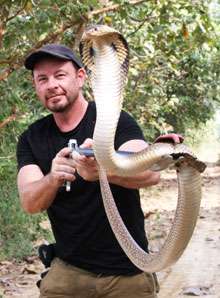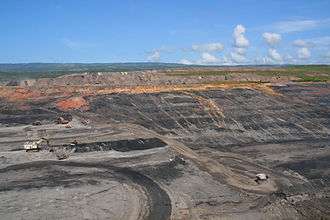Titanoboa: Monster Snake
Titanoboa: Monster Snake is a 2012 documentary film produced by the Smithsonian Institution. The documentary treats Titanoboa, the largest snake ever found. Fossils of the snake were uncovered from the Cerrejón Formation at Cerrejón, the tenth biggest coal mine in the world in the Cesar-Ranchería Basin of La Guajira, northern Colombia, covering an area larger than Washington, D.C.[1] The documentary premiered at the Smithsonian Channel on April 1, 2012, followed by a panel discussion from the scientists who spearheaded the research: Carlos Jaramillo from the Smithsonian Tropical Research Institute, Jonathan Bloch from the Florida Museum of Natural History and Jason Head from the University of Nebraska at Lincoln.[2]
| Titanoboa: Monster Snake | |
|---|---|
.jpg) Model of Titanoboa made for the documentary by the Smithsonian | |
| Original title | Titanoboa: Monster Snake |
| Directed by | Martin Kemp |
| Produced by | Wide-Eyed Entertainment |
| Based on | Titanoboa |
| Starring | Cast |
Release date |
|
Running time | 1:33:00 |
| Country | United States |
| Language | English |
Description
The documentary describes the finding of and scientific examination after Titanoboa. The tagline of the documentary is:[3]
Meet Titanoboa: She's longer than a bus, eats crocodiles for breakfast and makes the anaconda look like a garter snake."
The documentary was released on March 28, 2012 at the Baird auditorium of the Smithsonian National Museum of Natural History.[2]
From a fossil bed deep within Colombia's Cerrejón coal mine emerges Titanoboa, the largest snake ever found. This Paleocene reptile, from the epoch following the dinosaurs' demise, stretches our concept of what a snake can be. At 48 feet (14.6 m), this mega snake was longer than a school bus and was at the top of the monster-eat-monster food chain. Organized by the Smithsonian Institution Traveling Exhibition Service in collaboration with the Smithsonian Tropical Research Institute, the Smithsonian Channel, the Florida Museum of Natural History, and the University of Nebraska–Lincoln, Titanoboa: Monster Snake features a life-size—and incredibly life-like—model of the prehistoric creature as it swallows a crocodile whole. Featuring compelling text and video, the exhibition is an amazing look at a lost world and the incredible animals that inhabited it. Until 2004, no one knew what lived in the South American tropics during the Paleocene epoch (65.5 to 56 million years ago). Then, a student on a research expedition uncovered something remarkable, the first glimpse of a long-forgotten group of animals, with Titanoboa among them, a 60 million-year-old-beast that was able to crush and devour massive prehistoric crocodiles. For the team of paleontologists, finding Titanoboa was a once-in-a-lifetime discovery. This reptile, along with other significant fossils unearthed in the Cerrejón coal mine, provide the first glimpse of the earliest known rainforest.[4]
Cast

- Jonathan Bloch (himself)
- Edwin Cadena (himself)
- Percy Fawcett (archive photo)
- Alexander Hastings (himself)
- Jason Head (himself)
- Shawn Heflick (himself)
- Fabiany Herrera (himself)
- Kevin Hockley (himself)[5]
- Carlos Jaramillo (himself)
- P. David Polly (himself)
- Jesús Rivas (himself)
References
- How Titanoboa, the 40-Foot-Long Snake, Was Found at Smithsonian Institution
- Titanoboa: Monster Snake Premieres at the National Museum of Natural History March 28
- Titanoboa: Monster Snake Meet Titanoboa: She's longer than a bus, eats crocodiles for breakfast and makes the anaconda look like a garter snake on IMDb
- Titanoboa: Monster Snake at Smithsonian Institution
- Snake Found in Grand Central Station! at Smithsonian Institution
